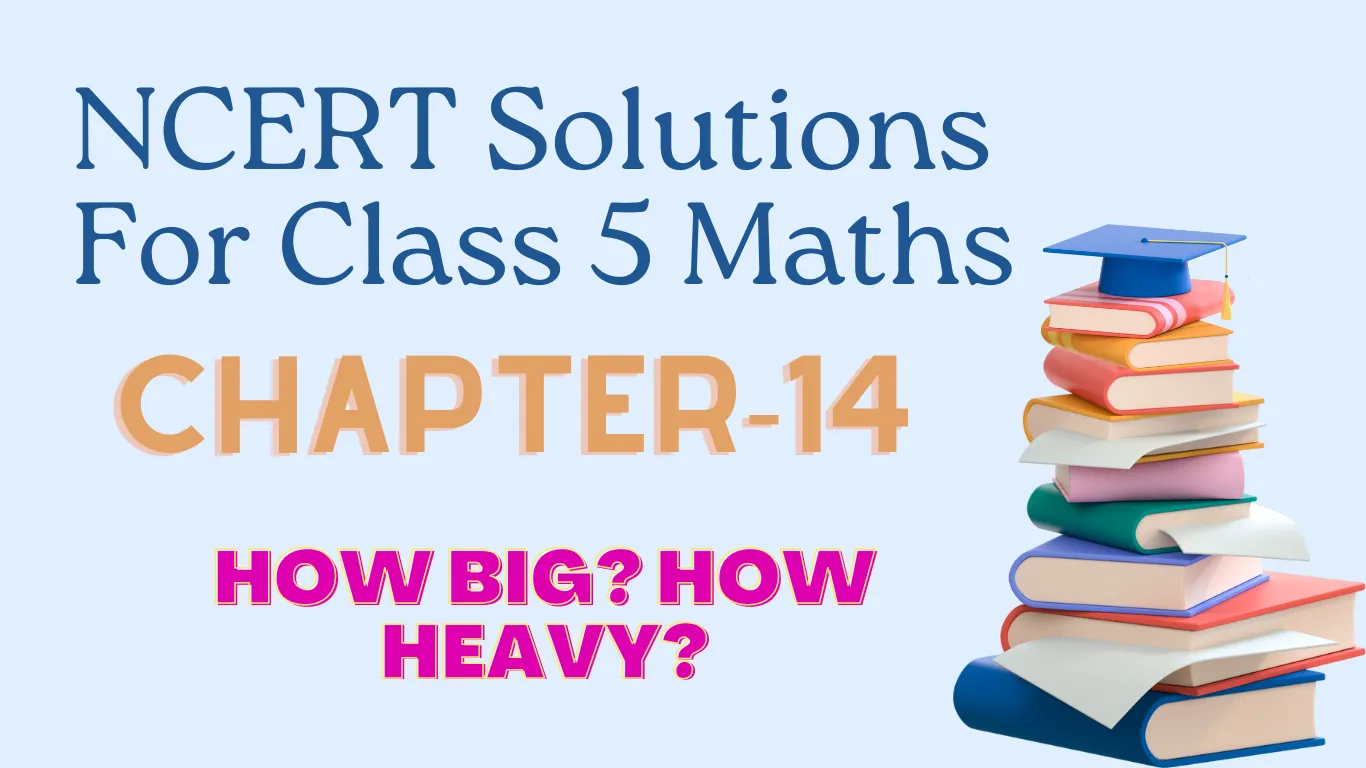NCERT Solutions for class 5 Maths Chapter 14 the NCERT Class 5 Maths textbook, “How Big? How Heavy?” introduces students to measurement, estimation, and comparison.NCERT Solutions Class 5 Maths Chapter-14 How Big? How Heavy? are provided here for students so that they can refer to solutions while preparing for the final exam. These solutions are prepared by experts in Maths subject based on the latest CBSE syllabus (2023-2024) for Class 5.NCERT provides solutions at the end of the chapter to help students understand and practice these concepts effectively. The solutions include step-by-step explanations, guiding students through problem-solving.
NCERT Solutions for Class 5 Maths How Big How Heavy book solutions are available in PDF format for free download. These ncert book chapter wise questions and answers are very helpful for CBSE and NCERT exam. CBSE recommends NCERT books and most of the questions in CBSE exam are asked from NCERT text books. Class 5 Maths chapter wise NCERT solution for Maths Book all the chapters can be downloaded from our website exammodalpaper.in for free.
NCERT Solutions for class 5 Maths Chapter 14 How Big? How Heavy?
Your Measuring Glass
1.Now make a guess. Do you think the volume of 10 five-rupee coins will be more than that of 10 marbles?
Guess the volume of each of these:
Ans.
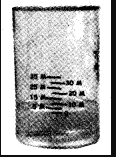
A ball is nearly 2 marbles.
An eraser is nearly 2 marbles.
A lemon is nearly 3 marbles.
A pencil is nearly 2 marbles.
A potato is nearly 4 marbles
2.Now make your own measuring glass using 35 marbles.
Take a glass of water and mark the level of water as ‘O’. Then put in 5 marbles and mark the level of water as 5 M.
Again drop 5 marbles and mark the level of water as 10 M. Likewise make the markings for 15 M, 20 M, 25 M, 30 M and 35 M.
Now put each thing in the measuring glass and check your guess.
Try with different things like a matchbox, a stone, etc. and fill the table.
Ans.

1.Which has More Volume?
Use your measuring bottle to find out:
(a) What is the volujne of 6 marbles?………………… mL
Ans. 7 mL.
(b) What is the volume of 16 one-rupee coins?…………………..mL
Ans. 18 mL.
(c) The volume of 24 marbles is………… mL.
Ans. 28 mL.
(d) The volume of 32 one-rupee coins?………………… mL
Ans. 36 mL.
(e) Mollie puts some five-rupee coins in the measuring bottle. How many coins has she put in it.
• If 30 mL water is pushed up?…………………
Ans. 27 coins.
• If 60 mL water is pushed up?…………….
Ans. 54 coins.
2.First guess and then use your measuring bottle to find out the volume in mL of
some other things.
Ans.
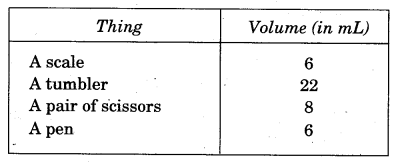
3.Guess how many litres of water your body will push up?
Ans. About 30 L.
Practice Time
Guess the volume of these things in cm cubes.
a) A matchbox is about _________ cm cubes.
b) A geometry box is about _______cm cubes.
c) An eraser is about __________ cm cubes.
d) How will you check your guess? Discuss.
Answer: a) Do it by yourself. Answers may vary. A sample answer is:
A matchbox is about 24 cm cubes.
b) Do it by yourself. Answers may vary. A sample answer is:
A geometry box is about 96 cm cubes.
c) Do it by yourself. Answers may vary. A sample answer is:
An eraser is about 2 cm cubes.
d) Use cm cubes to verify your answers.
She makes 4 such layers and her stage looks like this.
1.She used___________matchboxes to make this stage.
Ans.Number of matchboxes in 1 layer = 14
Hence, number of matchboxes in 4 layers = 14 x 4 = 56
2.The volume of one matchbox is the same as 10 cm cubes. Then the volume of this stage is same as________cm cubes.
Ans.Volume of 1 matchbox = 10 cubic cm
Hence, volume of 56 matchboxes = 10 x 56 = 560 cubic cm.
3.Which has more volume – your Math-Magic book or Tanu’s platform?
Ans.Tanu’s platform has more volume.
4.With your friends, collect many empty matchboxes of the same size. Measure the sides and write here.
•My matchbox is_____cm wide.
Ans. 3 cm
•It is_____ cm long
Ans. 5 cm
•It is_____cm high
Ans. 1 cm
Question 6: Use 56 matchboxes to make platforms of different heights. Fill this table.
Answer: Do it by yourself. Answers may vary. A sample answer is:

Question 7: The volume of each platform is equal to ________matchboxes.
Answer: Each platform is made up of 56 matchboxes. Therefore, the volume of each platform is equal to 56 matchboxes.
Question 8: The volume of each platform is equal to ________matchboxes.
Answer: Each platform is made up of 56 matchboxes. Therefore, the volume of each platform is equal to 56 matchboxes.
Question 9: Make deep drawings of the platforms you have made.
Answer: Do it by yourself. Answers will vary according to the platforms made.
Practice Time
Mohan arranged his matchboxes like this
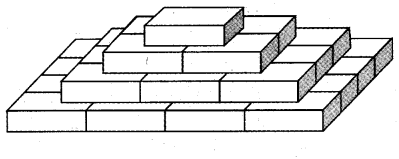
1.How many matchboxes did he use to make it? What is its volume in matchboxes? …….. matchboxes.
Ans. Mohan used 30 matchboxes (16 + 9 + 4 +1 = 30)
The volume is 30 matchboxes.
2.Collect empty matchboxes. Arrange them in an interesting way. Make a deep drawing of it.
Ans.One example is given below
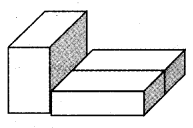
How Big is Your Cube?
1.(a)How long is the side of your cube? 7 cm.
(b)How many centimetres cubes can be arranged along its:
•Length? 7 cm
•Width? 7 cm 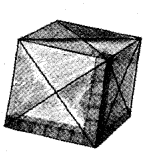
•Height? 7 cm
(c) Answer Thimpu’s questions:
•To make the first layer on the table how many cm cubes will I use?_________
Ans. 49 cm
•How many such layers will I need to make?
Ans.7 such layers.
(d) So the total cm cubes = (7x7x7) = 343
(e) The volume of the paper cube is same as cm cubes.
Ans.343 cm cubes.
2.Anan made a big cube having double the side of your paper cube. How many of your paper cubes will fit in it?
Try doing it by collecting all the cubes made in your class.
Ans.Side of Anan’s cube = 2 x 7 = 14 cm
We have arranged 2×2 = 4 paper cubes in first layer.
And 2 such layers of 4 paper cubes.
Hence, we can arrange 4×2 = 8 cubes
Packing Cubes
1.What is your guess? Who is right? –
Ans. Dinga is right.
2.How can Ganesh and Dinga test their guesses before packing the cubes in the boxes? Discuss with your friend.
Ans.Let us take the first box:
Length = 20 cm, Width = 10 cm, Height = 6 cm Hence, volume = 20 x 10 x 6 = 1200 cubic cm 12000 cubic cm < 4000 cubic cm
Second Box
Length = 11 cm, Width = 11 cm, Height = 10 cm
Hence, volume = 11 x 11 x 10 = 1210 cubic cm which is less than 4000 cubic cm
Third Box
Length = 15 cm, Width = 9 cm, Height = 10 cm ,
Hence, volume = 15 x 9 x 10 = 1350 cubic cm which is less than 4000 cubic cm. Adding the volumes of all these three boxes, we get 1200 + 1210 + 1350 = 3760
This is less than 4000 cubic cm and hence Dinga is right.
Which Pipe Fills More?
Collect some old postcards. You can also use thick paper of size 14 cm x 9 cm.
Fold the postcard along the width to make pipe 1. Join the ends with cello tape. Take another postcard and fold it along the length to make pipe 2. Join the ends with tape.
1.Guess which pipe can take more sand inside it. Hold it on a plate and pour sand to check your guess. Was your guess correct? Discuss.
Ans.Pipe 2 can take more sand. This was confirmed during checking.
2.Now do the same with other pipes shown here.To make the triangle shaped pipe 3, draw two lines on the postcard. Fold the postcard along the lines. Join the ends with tape.
Now make the square-shaped pipe 4.Find out which pipe can take the most sand inside it. So which pipe has the most volume?
Ans. Square-shaped pipe 4^has more volume.
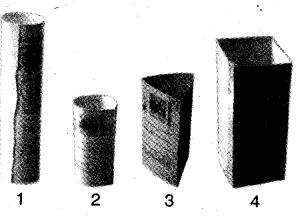
Trek to Gangotri
(a) For 6 days, each person will need
• Rice and flour =_________g
Ans.100 g + 100 g = 200 g 6 x 200 g = 1200 g
•Pulses =________g
Ans.1/3 of weight of rice and flour
= 1/3 x 1200 = 400 g
•Dried onions =_______g
Ans.10 x 6 g = 60 g
(b) How much of fresh tomatoes should be dried for 6 days for 10 people?
Ans.6 x 10 x 10 = 600 g
(c) What is the total weight of food (for 6 days) in each person’s bag?
Ans.
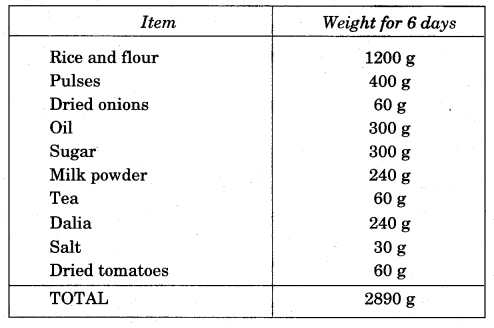
How Heavy Am I?
Do you remember the story of how Vaidika’s daughter found the weight of an elephant?
1.Can you guess the weight of the heaviest animal on this earth? No, it’s not me. I weigh only 5000 kg! It is the Blue Whale. Its weight is around 35 times more than me. So how many thousand kg does it weigh?
Ans.The weight of Blue Whale = 35 x 5000 = 175000 kg
2.Guess how many children of your weight will be equal to the weight of an elephant of 5000 kg.
Ans.Let us assume that weight of one child = 40 kg
Then number of children equal to weight of an elephant = 5000 + 40 = 1250
3.At birth, a baby elephant weighs around 90 kg. How much did you weigh when you were born? Find out. How many times is a baby elephant heavier than you were at birth?
Ans.Baby elephant’s weight = 90 kg
My weight at the time of birth = 3 kg So, baby elephant is; 90 3 = 30 times heavier
4.If a grown up elephant eats 136 kg of food in a day then it will eat around
___________ kg in a month.
Guess about how much it will eat in a year.
Ans.Food in a day = 136 kg
Hence, food in a month = 136 x 30 = 4080 kg And food in a year = 4080 x 12 = 48960 kg
Shahid Saves the Bank!
Shahid works in a bank. He sits at the cash counter. Whenever there are too many coins he does not count them. He just weighs them
1.How many coins are there in a sack of 5 rupee coins if it weighs:
(a) 18 kg?
Ans.18 kg = 18 x 1000 g = 18000 g Weight of 1 coin = 9 g
Hence, number of coins in 18000 g = 18000 ÷ 9 = 2000 coins
(b) 54 kg?
Ans.54 kg = 54 x 1000 = 54000 g
Number of coins in 54000 g = 54000 9 = 6000 coins
(c) 4500 kg?
Ans.4500 kg = 4500 x 1000 = 4500000 g
Number of coins in 4500000 g = 4500000 ÷ 9 = 900000 coins
(d)2 kg and 250 g?
Ans.2 kg and 250 g = 2 x 1000 g + 250 g = 2000 + 250 = 2250 g Number of coins = 2250 ÷ 9 = 250 coins
(e)1 kg and 125 g?
Ans.1 kg and 125 g
= 1 x 1000 g + 125 g = 1125 g Number of coins = 1125 ÷ 9 = 125 coins
2.2250 g can also be written as 2 kg and 250 g. Can you explain why?
Ans.We know that 1 kg = 1000 g
When 2250 g is divided by 1000; we get 2 as quotient and 250 as remainder. Hence, it can also be written as 2 kg and 250 g
3.A 2 rupee coin weighs 6 g. What is the weight of a sack with:
(a) 2200 coins?
Ans.‘Weight of 1 coin = 6 g
Hence, weight of 2200 coins
= 2200 x 6 = 13200 g = 13 kg and 200 g
(b)3000 coins •
Ans. Weight of 3000 coins
= 3000xx 6 = 18000 g = 18 kg
4.If 100 one rupee coins weigh 485 g, then how much will 10000 coins weigh?
Ans.Since 100 one rupee coins weigh 485 gm .,
Hence, weight of 1 coin = 485÷100
Hence, weight of 10000 coins = (485 ÷ 100) x 10000 = 485 x 100
= 48500 = 48 kg and 500 g.
Related Post :-
Chapter 1. The fish Tale
Chapter 2. Shapes and Angles
Chapter 3. How Many Squares?
Chapter 4. Parts and Wholes
Chapter 5. Does it Look the Same?
Chapter 6. Be My Multiple, I’ll be Your Factor
Chapter 7. Can You See the Pattern?
Chapter 8. Mapping Your Way
Chapter 9. Boxes and Sketches
Chapter 10. Tenths and Hundredths
Chapter 11. Area and its Boundary
Chapter 12. Smart Charts
Chapter 13. Ways to Multiply and Divide
Chapter 14. How Big? How Heavy?
NCERT Solutions Class 5 to 10
- NCERT Solutions for class 5 Maths
- NCERT Solutions for class 5 EVS
- NCERT Solutions for class 5 Paryayana Adyayan
- NCERT Solutions for class 5 English
- NCERT Solutions for class 5 Hindi
Frequently Asked Questions on NCERT Solutions for Class 5 Maths Chapter 14
Q1: What is NCERT Solutions for Class 5 Maths Chapter 14?
A1: NCERT Solutions for Class 5 Maths Chapter 14 refers to the solutions provided by the National Council of Educational Research and Training (NCERT) for the mathematical concepts covered in Chapter 14 of the Class 5 Maths textbook.
Q2: Why should I use NCERT Solutions for Class 5 Maths Chapter 14?
A2: NCERT Solutions are designed by subject experts and provide a comprehensive understanding of the mathematical concepts covered in the chapter.
Q3: How can I access the NCERT Solutions for Class 5 Maths Chapter 14?
A3: You can access the NCERT Solutions for Class 5 Maths Chapter 14 through various mediums such as online platforms, educational websites, or the official NCERT website. They are also available in printed format in the form of textbooks.
Q4: Are the solutions in NCERT Solutions for Class 5 Maths Chapter 14 accurate?
A4: Yes, the solutions provided in NCERT Solutions for Class 5 Maths Chapter 14 are prepared by subject matter experts and reviewed extensively. They are considered accurate and reliable for understanding and solving the mathematical problems.
Q5: Can I rely solely on NCERT Solutions for Class 5 Maths Chapter 14 to prepare for my exams?
A5: NCERT Solutions are a valuable resource for exam preparation.
Q6: Are there any additional resources I can use alongside NCERT Solutions for Class 5 Maths Chapter 14?
A6: Yes, you can use other resources such as practice workbooks, online math tutorials, interactive learning platforms, and reference books to reinforce your understanding of the concepts covered in Chapter 14.
Q7: How can NCERT Solutions for Class 5 Maths Chapter 14 help me improve my math skills?
A7: NCERT Solutions provide step-by-step explanations, examples, and practice questions to help you understand and solve mathematical problems effectively. Regularly practicing these solutions can enhance your problem-solving abilities and strengthen your math skills.
Q8: Can NCERT Solutions for Class 5 Maths Chapter 14 be used by students of other classes or grades?
A8: NCERT Solutions for Class 5 Maths Chapter 14 are specifically designed for Class 5 students. However, the concepts covered in the chapter may be relevant to students of other grades as well, depending on their curriculum and syllabus.
Q9: Are there any exercises or practice questions in NCERT Solutions for Class 5 Maths Chapter 14?
A9: Yes, NCERT Solutions for Class 5 Maths Chapter 14 include exercises and practice questions at the end of the chapter.
Q10: Can I get step-by-step explanations for the solutions in NCERT Solutions for Class 5 Maths Chapter 14?
A10: Yes, NCERT Solutions for Class 5 Maths Chapter 14 provide step-by-step explanations for each question and problem. The detailed solutions can help you understand the logic and approach required to solve the mathematical problems effectively.
